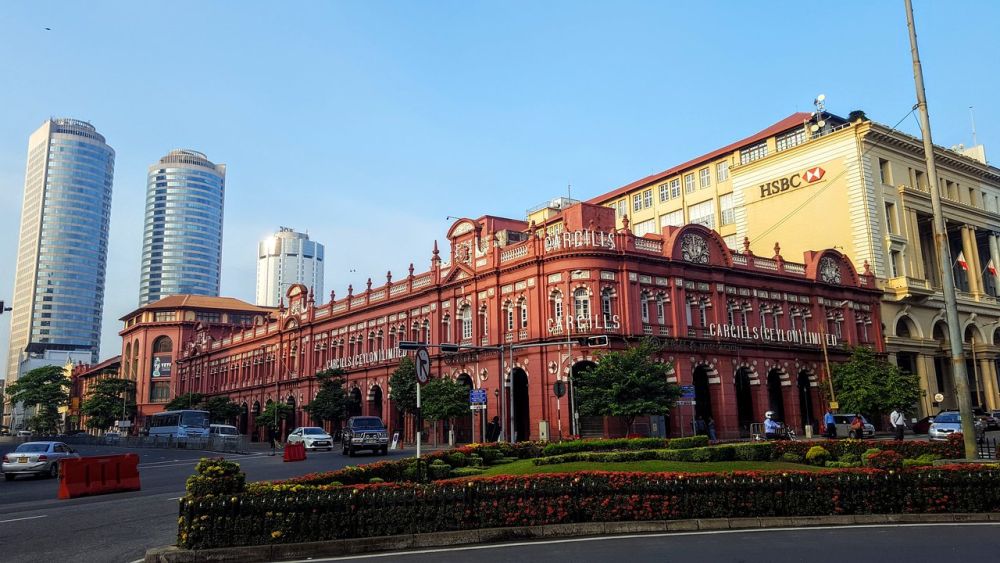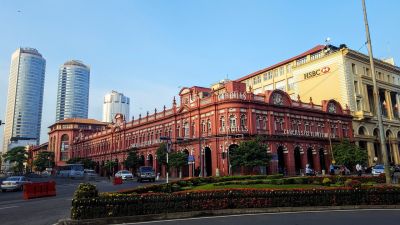

Galle Face Green is a half-kilometer promenade along the coast in the heart of Colombo, Sri Lanka. This urban park, which stretches for 12 acres between Galle Road and the Indian Ocean, is a favorite spot for both locals and tourists. Visitors to Galle Face Green can enjoy a leisurely stroll, fly kites, and witness spectacular sunsets over the ocean. The area is also popular for street food, offering a variety of local snacks like isso wade (shrimp fritters) and kottu. Spending time at the Galle Face Green provides a refreshing break from the bustling city life and an opportunity to observe the local culture firsthand.
The Colombo Fort Railway Station is a key landmark and transport hub in Colombo. The station itself is steeped in history, dating back to 1908, and features a blend of colonial and South Asian architectural styles. Travelers can explore the station to learn about Sri Lanka's railway history or even embark on a train journey along the coastline. The area is often busy with locals commuting to various parts of the island, offering a glimpse into the daily life in Colombo. Tours can be self-guided or with a local guide who can provide detailed insights into the station's history and significance.
The Colombo Dutch Museum is a historical gem situated in the Fort area of Colombo. Housed in a restored colonial building that once served as a mansion for the Dutch governor and later as a college, the museum showcases the history of the Dutch colonial rule in Sri Lanka. It features artifacts, documents, and exhibits that provide an in-depth look at the life and times of the Dutch colonials. Visitors can explore the museum's collection of furniture, ceramics, coins, and weaponry, all offering a glimpse into the Dutch era. The museum's tranquil courtyard is a beautiful spot to relax after perusing the exhibits.
The Old Colombo Lighthouse is a historic beacon located near the heart of Fort, Colombo. Although it no longer functions as a lighthouse, its striking white tower, built in 1952, still stands as a symbol of Colombo's maritime heritage. Visitors can admire the lighthouse's beautiful structure and the surrounding views of the Indian Ocean and Colombo's bustling port. While access to the inside of the lighthouse tower is restricted, the surrounding area is perfect for a relaxed stroll and for capturing memorable photographs of one of Colombo's iconic landmarks.
The Colombo Lotus Tower is one of the most visible landmarks in the city's skyline and represents the lotus flower, symbolizing purity. Standing at 350 meters, it's the tallest self-supported structure in South Asia. Visitors to the Lotus Tower can take an elevator to the observation decks, which offer panoramic views of Colombo and the surrounding ocean. The tower also houses a museum, a restaurant, and conference facilities. Whether visiting during the day or evening, the Lotus Tower provides breathtaking vistas and photo opportunities, making it a must-visit destination in Colombo Fort.
Pettah Market is a bustling and vibrant open-air market that sprawls through a network of streets just east of Colombo Fort. It's a place where tourists and locals alike come to find a wide array of goods at bargain prices. From textiles, clothing, and accessories to electronics, spices, and fresh produce, Pettah Market has it all. It's an intense sensory experience with sights, sounds, and smells that are quintessentially Sri Lankan. Exploring the market requires stamina but provides a feel for the real commerce and culture in Colombo. Visitors should be prepared to haggle and interact with friendly vendors.
The National Museum of Colombo, situated in Fort, is the largest museum in Sri Lanka. Established in 1877 by Sir William Henry Gregory, the then British Governor of Ceylon, the museum houses a vast collection of Sri Lankan historical and cultural artifacts. Ancient carvings, sculptures, and regal artifacts of Sri Lankan royalty, including the throne and crown of the Kandyan monarchs, are displayed with care. With intricate architecture and lush gardens, the museum building itself is as impressive as its contents. The museum is great for history enthusiasts and those curious about the cultural heritage of the island.
Independence Memorial Hall is an iconic structure commemorating the independence of Sri Lanka from British rule in 1948. Located in the Cinnamon Gardens area, a short distance from Colombo Fort, this historical building is set amidst beautiful gardens and a peaceful setting. It’s a popular spot for both tourists and locals who come to pay respect and enjoy the serene atmosphere. The architecture of the hall reflects the country’s heritage with its stone carvings and traditional designs. The surrounding park offers a nice place to walk, and an on-site museum provides insight into Sri Lanka's struggle for independence.
Gangaramaya Temple is not just a place of worship but also a temple complex rich in history and cultural diversity. Situated near the Beira Lake in Colombo, it boasts a mix of Sri Lankan, Thai, Indian, and Chinese architecture. The temple is filled with an expansive array of Buddhist statues and has a museum that exhibits a vast collection of relics from various parts of Asia and beyond. A visit to Gangaramaya provides a relaxing and educational experience for anyone interested in Buddhism, architecture, or Sri Lankan culture. The temple's tranquil environment, with its impressive Bodhi tree, makes for a perfect retreat from the city's hustle and bustle.
The World Trade Center (WTC) in Colombo is a focal point for business and commerce in Sri Lanka. Towering over the Fort area, it consists of twin towers connected by a bridge and stands as one of the tallest buildings in the country. Visitors can explore the various shops, enjoy a meal at one of the restaurants, or simply marvel at the building's modern architectural design. The complex is also adjacent to the Bank of Ceylon tower, adding to the impressive skyline. While primarily a business hub, the WTC provides tourists with a glimpse into the economic heart of Sri Lanka.
